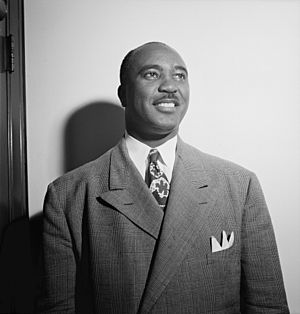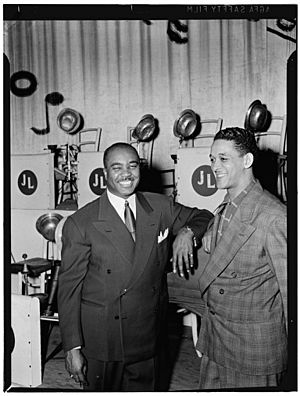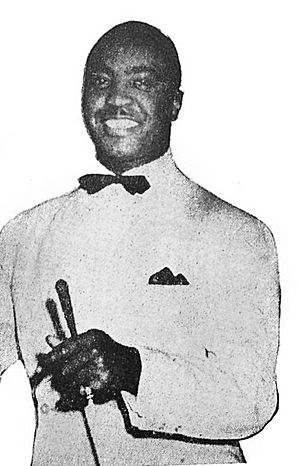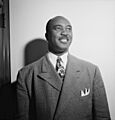Jimmie Lunceford facts for kids
Quick facts for kids
Jimmie Lunceford
|
|
|---|---|
 |
|
| Background information | |
| Birth name | James Melvin Lunceford |
| Born | June 6, 1902 Fulton, Mississippi, U.S. |
| Died | July 12, 1947 (aged 45) Seaside, Oregon, U.S. |
| Genres | Jazz, swing, traditional pop |
| Occupation(s) | Musician, bandleader |
| Instruments | Saxophone, flute |
| Labels | Decca, Columbia |
James Melvin Lunceford (born June 6, 1902 – died July 12, 1947) was an American jazz musician. He played the alto saxophone and led a famous band during the swing era.
Contents
Early Life and Music Beginnings
Jimmie Lunceford was born on a farm in Fulton, Mississippi, in 1902. His father, James, owned the farm. His mother, Idella, was a talented organ player. When Jimmie was seven months old, his family moved to Oklahoma City.
Later, his family moved to Denver, Colorado. There, Jimmie went to high school and learned music. His teacher was Wilberforce J. Whiteman, whose son, Paul Whiteman, became a very famous bandleader. Jimmie learned to play many instruments as a child.
After high school, Jimmie continued his music studies at Fisk University. In 1922, he played alto saxophone in a local band. This band was led by violinist George Morrison. Another future bandleader, Andy Kirk, was also in this band.
Leading a Famous Band
In 1927, Jimmie Lunceford was a sports instructor at Manassas High School in Memphis, Tennessee. He started a student band called the Chickasaw Syncopators. This band later changed its name to the Jimmie Lunceford Orchestra.
The band began its professional career in 1929. They made their first recordings in 1930. Jimmie Lunceford was the first public high school band director in Memphis.
Playing at the Cotton Club
After touring for a while, the band got a big chance in 1934. They were invited to play at The Cotton Club in Harlem, New York. This famous nightclub had already featured jazz legends like Duke Ellington and Cab Calloway.
The Cotton Club was known for its exciting shows. Lunceford's orchestra was perfect for the club. They were known for their amazing music and funny performances. This helped Jimmie Lunceford's reputation grow quickly.
The Lunceford Style
Jimmie Lunceford's band was special. Unlike other bands, it was famous for its whole sound, not just its solo players. They also used a unique "two-beat" rhythm. Most bands used a four-beat rhythm.
This special "Lunceford style" came from the creative music arrangements by trumpeter Sy Oliver. His arrangements set a high standard for other dance bands. Even though Jimmie Lunceford wasn't known as a main musician, he could play many instruments. He even played the flute in one song called "Liza."
Comedy and Professionalism
Comedy was a big part of Lunceford's shows. They performed funny songs like "Rhythm Is Our Business." Their shows often included costumes and skits. They sometimes even made jokes about other famous white bands.
Even with the humor, Lunceford always made sure the music was top-notch. He was a former teacher, and he brought that professionalism to his band. During the peak of swing music in the 1930s, his orchestra was considered as good as bands led by Duke Ellington, Earl Hines, or Count Basie.
You can hear their precise playing in songs like "For Dancers Only." The band's saxophone section was especially famous. It was led by Willie Smith. Jimmie Lunceford often used a special stick, called a conducting baton, to lead his band.
Recordings and Tours
The orchestra started recording for the Decca label. Later, they signed with Columbia in 1938. They toured Europe in 1937. However, they had to cancel another tour in 1939 because World War II started.
The band also appeared in the 1941 movie Blues in the Night. Over time, many of Lunceford's musicians left for other bands. This was because they were not paid as well. This led to the band's popularity slowly going down.
Death
On July 12, 1947, Jimmie Lunceford and his orchestra were in Seaside, Oregon. They were there to play at a dance hall. Before the show, Lunceford collapsed while signing autographs at a record store.
He died while being taken to the hospital. Jimmie Lunceford was 45 years old. Doctors said he died of a heart problem. He was buried in Elmwood Cemetery in Memphis, Tennessee.
Legacy and Impact
After Jimmie Lunceford's death, some band members tried to keep the orchestra going. These included Eddie Wilcox and Joe Thomas. But the Jimmie Lunceford Orchestra finally broke up in 1949.
In 1999, a bandleader named Robert Veen started a new project. He wanted to use the original music and arrangements of Jimmie Lunceford's band. In 2005, "The Jimmie Lunceford Legacy Orchestra" officially started playing.
The Jimmie Lunceford Jamboree Festival was created in 2007. Its goal is to help people remember Lunceford's important contributions to jazz. This is especially true in Memphis, Tennessee, where he had strong ties.
Lunceford's music is still important today. His song "Rhythm is Our Business" was included in a jazz music collection in 2004. In 2009, a special brass note was placed for Lunceford on the Beale Street Walk of Fame in Memphis. This honors his place in music history.
Selected Discography
Jimmie Lunceford recorded many songs throughout his career. Here are some of his early recordings:
- "In Dat Mornin'"/"Sweet Rhythm" (Victor V-38141) - recorded June 6, 1930
- "Jazznocracy"/"Chillun, Get Up" (Victor 24522) - recorded January 26, 1934
- "White Heat"/"Leaving Me" (Victor 24586) - recorded January 26, 1934
He also made many recordings for Decca Records and Columbia Records. Later, all his recordings were put together in a 10-volume series called The Chronological Jimmie Lunceford & His Orchestra.
Images for kids
See also
 In Spanish: Jimmie Lunceford para niños
In Spanish: Jimmie Lunceford para niños






